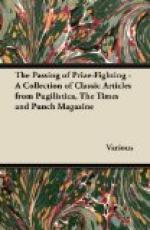Among the many things I like in DORETHEA CONYERS’ novels is the artistic subtlety, achieved by few of our other novelists, with which she manages to write them as it were in character. I am quite sure that if Berenice Ermyntrude Nicosia Nevin, who is called by her initials on the cover and inside by what they spell, had tried to write a novel it would have been remarkably like B.E.N. (METHUEN). There would have been the same keen delight in horses, hunting and Irish scenery, and the same cheerful disregard for such trifles as spelling or such conventions as making quite sure that your reader knows which character is speaking at any given moment, and the same excellent humour, which, if it is at the expense of the Irish, is kindly enough for all that. It seems to me that in her new novel Mrs. CONYERS, wisely refusing to stray to that suburbia in which her gifts lack this charm, has recaptured much of the careless rapture of her earliest books; and very careless and very rapturous they wore. But I am not quite sure that in real life even Ben, when as second whip to the East Cara hounds she lost her horse, would have found an aeroplane useful to catch up with. In case it should be objected that anything so funny as the tea at Miss Talty’s never could happen, even in the Caher Valley district, I want to put it on record here and now that it could and does.
* * * * *
The Mystery Keepers (LANE), by MARION FOX, reminds me of the old riddle, “What is it that has feathers and two legs, and barks like a dog?”—the answer being a stork. People who protest that a stork doesn’t bark like a dog are told that that part is put in to make it harder. I find that the greater part of the mystery kept by The Mystery Keepers is put in to make it harder. The Abbey at Clynch St. Mary has a “coise” put on it by the last Abbess, and every direct male heir expires punctually on his twenty-first birthday. The actual agency is a poisoned ring concealed in the frame of a portrait of the malevolent Abbess and is in the custody of the Otway family, who enjoy a prescriptive if nebulous right to be stewards of the property. Just how or why the Otways—noble fellows, we are given to understand—carry out the deceased Abbess’s nefarious wishes with such precision and despatch is not explained. Anyway the mother of the last victim, who has found out the secret, steals the ring, murders the Otway of the period, and retires to a lunatic asylum after her son has himself stolen the ring from her workbox and poisoned himself into the next world. That finishes it. The ring retires to a museum and the proper people marry each other. It is a slender and quite impossible story, but told in a clever way which goes far to redeem its lack of substance.
* * * * *




